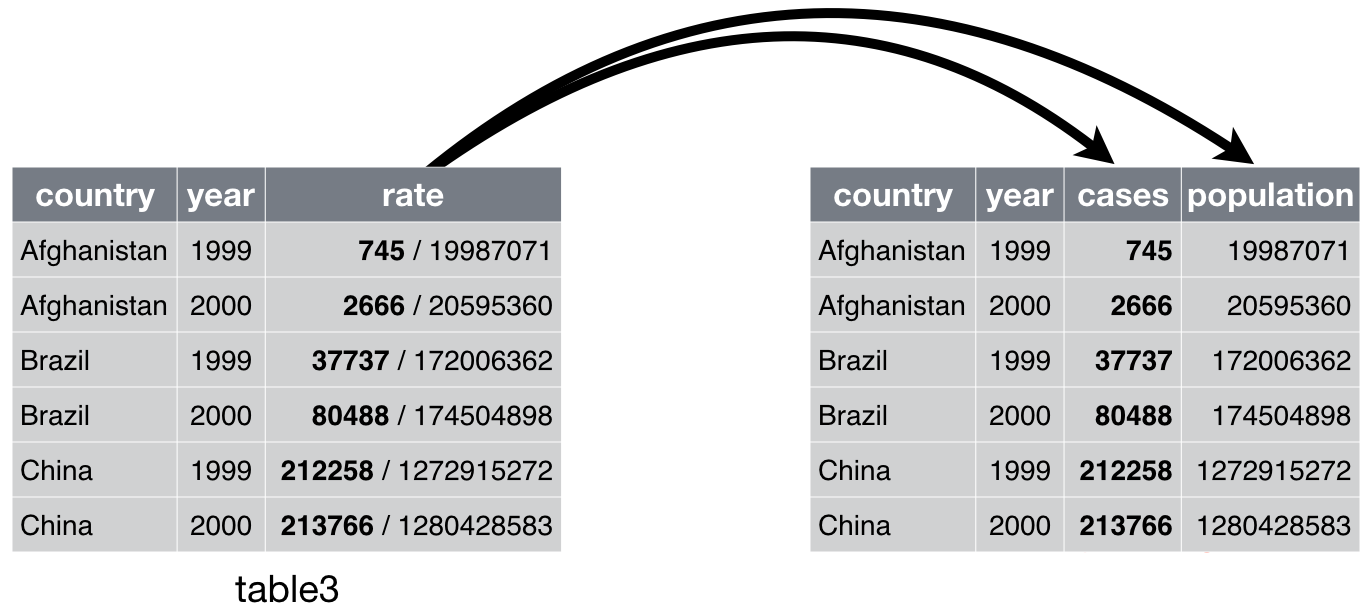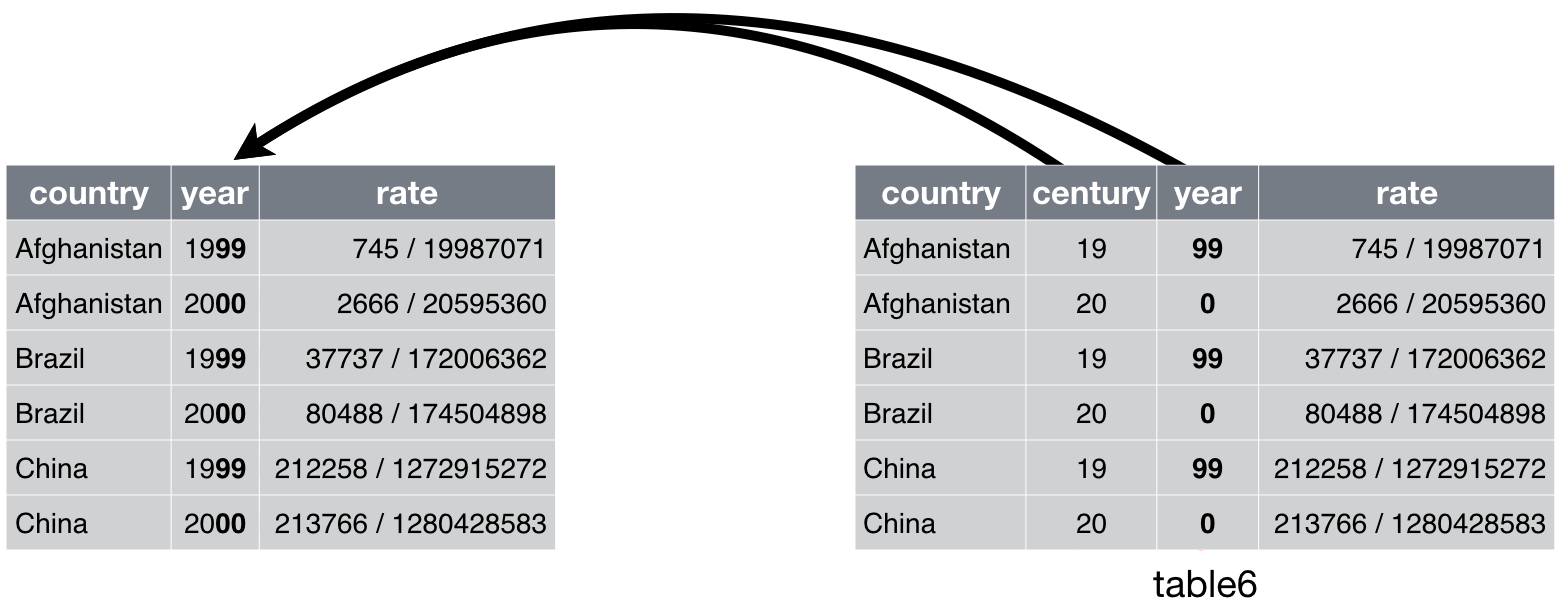Separating and uniting data
2023-02-27
Introduction
The problem
What’s different between these data sets?
What needs to happen to create data2 from data1?
data1# A tibble: 11 × 4
id cond1 cond2 date
<int> <int> <chr> <date>
1 1 1 A 2022-02-06
2 1 2 A 2022-01-17
3 1 3 A 2022-01-27
4 2 1 B 2022-02-28
5 2 3 B 2022-02-15
6 3 1 A 2022-01-20
7 3 2 A 2022-01-11
8 3 3 A 2022-01-30
9 4 1 B 2022-02-26
10 4 2 B 2022-01-24
11 4 3 B 2022-01-05data2# A tibble: 12 × 5
id condition year month day
<int> <chr> <chr> <chr> <chr>
1 1 1A 2022 02 06
2 1 2A 2022 01 17
3 1 3A 2022 01 27
4 2 1B 2022 02 28
5 2 2B <NA> <NA> <NA>
6 2 3B 2022 02 15
7 3 1A 2022 01 20
8 3 2A 2022 01 11
9 3 3A 2022 01 30
10 4 1B 2022 02 26
11 4 2B 2022 01 24
12 4 3B 2022 01 05 Mental model of tidy data

- Each variable has its own column
- Each observation has its own row
- Each value has its own cell
Separating data
Separating data
table3# A tibble: 6 × 3
country year rate
<chr> <dbl> <chr>
1 Afghanistan 1999 745/19987071
2 Afghanistan 2000 2666/20595360
3 Brazil 1999 37737/172006362
4 Brazil 2000 80488/174504898
5 China 1999 212258/1272915272
6 China 2000 213766/1280428583Why is table3 not tidy?

Separating data
separate(table3, rate, into = c("cases", "population"))# A tibble: 6 × 4
country year cases population
<chr> <dbl> <chr> <chr>
1 Afghanistan 1999 745 19987071
2 Afghanistan 2000 2666 20595360
3 Brazil 1999 37737 172006362
4 Brazil 2000 80488 174504898
5 China 1999 212258 1272915272
6 China 2000 213766 1280428583separate(table3, rate, into = c("cases", "population"), convert = TRUE)# A tibble: 6 × 4
country year cases population
<chr> <dbl> <int> <int>
1 Afghanistan 1999 745 19987071
2 Afghanistan 2000 2666 20595360
3 Brazil 1999 37737 172006362
4 Brazil 2000 80488 174504898
5 China 1999 212258 1272915272
6 China 2000 213766 1280428583Separating data
separate(table3, year, into = c("century", "year2"), sep = 2)# A tibble: 6 × 4
country century year2 rate
<chr> <chr> <chr> <chr>
1 Afghanistan 19 99 745/19987071
2 Afghanistan 20 00 2666/20595360
3 Brazil 19 99 37737/172006362
4 Brazil 20 00 80488/174504898
5 China 19 99 212258/1272915272
6 China 20 00 213766/1280428583separate(table3, year, into = c("century", "year2"), sep = 2, remove = FALSE)# A tibble: 6 × 5
country year century year2 rate
<chr> <dbl> <chr> <chr> <chr>
1 Afghanistan 1999 19 99 745/19987071
2 Afghanistan 2000 20 00 2666/20595360
3 Brazil 1999 19 99 37737/172006362
4 Brazil 2000 20 00 80488/174504898
5 China 1999 19 99 212258/1272915272
6 China 2000 20 00 213766/1280428583Separating data
Warning
The separate() function is being superseded by separate_wider_delim() and separate_wider_position() for the two use cases described before. But these are both listed as experimental, so we’re sticking with separate().
separate(table3, rate, into = c("cases", "population"), sep = "/")
separate_wider_delim(table3, rate, names = c("cases", "population"), delim = "/")
Separating data
Warning
The separate() function is being superseded by separate_wider_delim() and separate_wider_position() for the two use cases described before. But these are both listed as experimental, so we’re sticking with separate().
separate(table3, year, into = c("century", "year2"), sep = 2)
separate_wider_position(table3, year, widths = c(century = 2, year2 = 2))
Uniting data
Uniting data
table5# A tibble: 6 × 4
country century year rate
<chr> <chr> <chr> <chr>
1 Afghanistan 19 99 745/19987071
2 Afghanistan 20 00 2666/20595360
3 Brazil 19 99 37737/172006362
4 Brazil 20 00 80488/174504898
5 China 19 99 212258/1272915272
6 China 20 00 213766/1280428583Why is table5 not tidy?

Uniting data
unite(table5, new, century:year)# A tibble: 6 × 3
country new rate
<chr> <chr> <chr>
1 Afghanistan 19_99 745/19987071
2 Afghanistan 20_00 2666/20595360
3 Brazil 19_99 37737/172006362
4 Brazil 20_00 80488/174504898
5 China 19_99 212258/1272915272
6 China 20_00 213766/1280428583unite(table5, new, century:year, sep = "")# A tibble: 6 × 3
country new rate
<chr> <chr> <chr>
1 Afghanistan 1999 745/19987071
2 Afghanistan 2000 2666/20595360
3 Brazil 1999 37737/172006362
4 Brazil 2000 80488/174504898
5 China 1999 212258/1272915272
6 China 2000 213766/1280428583Uniting data
unite(table5, new, century:year, sep = "", remove = FALSE)# A tibble: 6 × 5
country new century year rate
<chr> <chr> <chr> <chr> <chr>
1 Afghanistan 1999 19 99 745/19987071
2 Afghanistan 2000 20 00 2666/20595360
3 Brazil 1999 19 99 37737/172006362
4 Brazil 2000 20 00 80488/174504898
5 China 1999 19 99 212258/1272915272
6 China 2000 20 00 213766/1280428583Coalescing data
coal_data# A tibble: 4 × 3
a_1 a_2 a_3
<dbl> <dbl> <dbl>
1 1 NA NA
2 NA 4 NA
3 NA NA 7
4 NA NA NAcoal_data %>% # note the use of magrittr pipe!
mutate(a_all = coalesce(!!! select(., contains("a_"))))# A tibble: 4 × 4
a_1 a_2 a_3 a_all
<dbl> <dbl> <dbl> <dbl>
1 1 NA NA 1
2 NA 4 NA 4
3 NA NA 7 7
4 NA NA NA NAIncomplete data sets
Missing data
stocks# A tibble: 7 × 3
year qtr return
<dbl> <dbl> <dbl>
1 2015 1 1.88
2 2015 2 0.59
3 2015 3 0.35
4 2015 4 NA
5 2016 2 0.92
6 2016 3 0.17
7 2016 4 2.66- Explicitly missing (Q4 2015 is
NA) - Implicitly missing (Q1 2016 absent)
stocks |>
complete(year, qtr)# A tibble: 8 × 3
year qtr return
<dbl> <dbl> <dbl>
1 2015 1 1.88
2 2015 2 0.59
3 2015 3 0.35
4 2015 4 NA
5 2016 1 NA
6 2016 2 0.92
7 2016 3 0.17
8 2016 4 2.66Important for factorial designs and for data validation
Combinations of factors
fruits# A tibble: 6 × 4
type year size weights
<chr> <dbl> <fct> <dbl>
1 apple 2010 XS 1.87
2 orange 2010 S 2.64
3 apple 2012 M 5.68
4 orange 2010 S 3.70
5 orange 2010 S 4.19
6 orange 2012 M 5.83fruits |> expand(type, size)# A tibble: 8 × 2
type size
<chr> <fct>
1 apple XS
2 apple S
3 apple M
4 apple L
5 orange XS
6 orange S
7 orange M
8 orange L return all possible combinations
Combinations of factors
fruits# A tibble: 6 × 4
type year size weights
<chr> <dbl> <fct> <dbl>
1 apple 2010 XS 1.87
2 orange 2010 S 2.64
3 apple 2012 M 5.68
4 orange 2010 S 3.70
5 orange 2010 S 4.19
6 orange 2012 M 5.83fruits |> expand(nesting(type, size))# A tibble: 4 × 2
type size
<chr> <fct>
1 apple XS
2 apple M
3 orange S
4 orange M return all existing combinations
Filling data
treatment# A tibble: 4 × 3
person treatment response
<chr> <dbl> <dbl>
1 Derrick Whitmore 1 7
2 <NA> 2 10
3 <NA> 3 9
4 Katherine Burke 1 4treatment |>
fill(person)# A tibble: 4 × 3
person treatment response
<chr> <dbl> <dbl>
1 Derrick Whitmore 1 7
2 Derrick Whitmore 2 10
3 Derrick Whitmore 3 9
4 Katherine Burke 1 4Solving the problem
What code turns data1 into data2?
data1# A tibble: 11 × 4
id cond1 cond2 date
<int> <int> <chr> <date>
1 1 1 A 2022-02-06
2 1 2 A 2022-01-17
3 1 3 A 2022-01-27
4 2 1 B 2022-02-28
5 2 3 B 2022-02-15
6 3 1 A 2022-01-20
7 3 2 A 2022-01-11
8 3 3 A 2022-01-30
9 4 1 B 2022-02-26
10 4 2 B 2022-01-24
11 4 3 B 2022-01-05data2# A tibble: 12 × 5
id condition year month day
<int> <chr> <chr> <chr> <chr>
1 1 1A 2022 02 06
2 1 2A 2022 01 17
3 1 3A 2022 01 27
4 2 1B 2022 02 28
5 2 2B <NA> <NA> <NA>
6 2 3B 2022 02 15
7 3 1A 2022 01 20
8 3 2A 2022 01 11
9 3 3A 2022 01 30
10 4 1B 2022 02 26
11 4 2B 2022 01 24
12 4 3B 2022 01 05